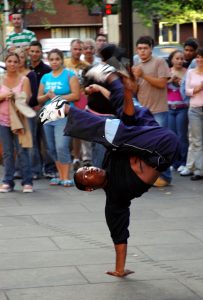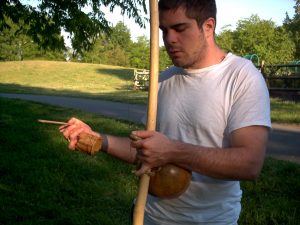5.4: Capoeira
- Page ID
- 119993
\( \newcommand{\vecs}[1]{\overset { \scriptstyle \rightharpoonup} {\mathbf{#1}} } \)
\( \newcommand{\vecd}[1]{\overset{-\!-\!\rightharpoonup}{\vphantom{a}\smash {#1}}} \)
\( \newcommand{\dsum}{\displaystyle\sum\limits} \)
\( \newcommand{\dint}{\displaystyle\int\limits} \)
\( \newcommand{\dlim}{\displaystyle\lim\limits} \)
\( \newcommand{\id}{\mathrm{id}}\) \( \newcommand{\Span}{\mathrm{span}}\)
( \newcommand{\kernel}{\mathrm{null}\,}\) \( \newcommand{\range}{\mathrm{range}\,}\)
\( \newcommand{\RealPart}{\mathrm{Re}}\) \( \newcommand{\ImaginaryPart}{\mathrm{Im}}\)
\( \newcommand{\Argument}{\mathrm{Arg}}\) \( \newcommand{\norm}[1]{\| #1 \|}\)
\( \newcommand{\inner}[2]{\langle #1, #2 \rangle}\)
\( \newcommand{\Span}{\mathrm{span}}\)
\( \newcommand{\id}{\mathrm{id}}\)
\( \newcommand{\Span}{\mathrm{span}}\)
\( \newcommand{\kernel}{\mathrm{null}\,}\)
\( \newcommand{\range}{\mathrm{range}\,}\)
\( \newcommand{\RealPart}{\mathrm{Re}}\)
\( \newcommand{\ImaginaryPart}{\mathrm{Im}}\)
\( \newcommand{\Argument}{\mathrm{Arg}}\)
\( \newcommand{\norm}[1]{\| #1 \|}\)
\( \newcommand{\inner}[2]{\langle #1, #2 \rangle}\)
\( \newcommand{\Span}{\mathrm{span}}\) \( \newcommand{\AA}{\unicode[.8,0]{x212B}}\)
\( \newcommand{\vectorA}[1]{\vec{#1}} % arrow\)
\( \newcommand{\vectorAt}[1]{\vec{\text{#1}}} % arrow\)
\( \newcommand{\vectorB}[1]{\overset { \scriptstyle \rightharpoonup} {\mathbf{#1}} } \)
\( \newcommand{\vectorC}[1]{\textbf{#1}} \)
\( \newcommand{\vectorD}[1]{\overrightarrow{#1}} \)
\( \newcommand{\vectorDt}[1]{\overrightarrow{\text{#1}}} \)
\( \newcommand{\vectE}[1]{\overset{-\!-\!\rightharpoonup}{\vphantom{a}\smash{\mathbf {#1}}}} \)
\( \newcommand{\vecs}[1]{\overset { \scriptstyle \rightharpoonup} {\mathbf{#1}} } \)
\( \newcommand{\vecd}[1]{\overset{-\!-\!\rightharpoonup}{\vphantom{a}\smash {#1}}} \)
\(\newcommand{\avec}{\mathbf a}\) \(\newcommand{\bvec}{\mathbf b}\) \(\newcommand{\cvec}{\mathbf c}\) \(\newcommand{\dvec}{\mathbf d}\) \(\newcommand{\dtil}{\widetilde{\mathbf d}}\) \(\newcommand{\evec}{\mathbf e}\) \(\newcommand{\fvec}{\mathbf f}\) \(\newcommand{\nvec}{\mathbf n}\) \(\newcommand{\pvec}{\mathbf p}\) \(\newcommand{\qvec}{\mathbf q}\) \(\newcommand{\svec}{\mathbf s}\) \(\newcommand{\tvec}{\mathbf t}\) \(\newcommand{\uvec}{\mathbf u}\) \(\newcommand{\vvec}{\mathbf v}\) \(\newcommand{\wvec}{\mathbf w}\) \(\newcommand{\xvec}{\mathbf x}\) \(\newcommand{\yvec}{\mathbf y}\) \(\newcommand{\zvec}{\mathbf z}\) \(\newcommand{\rvec}{\mathbf r}\) \(\newcommand{\mvec}{\mathbf m}\) \(\newcommand{\zerovec}{\mathbf 0}\) \(\newcommand{\onevec}{\mathbf 1}\) \(\newcommand{\real}{\mathbb R}\) \(\newcommand{\twovec}[2]{\left[\begin{array}{r}#1 \\ #2 \end{array}\right]}\) \(\newcommand{\ctwovec}[2]{\left[\begin{array}{c}#1 \\ #2 \end{array}\right]}\) \(\newcommand{\threevec}[3]{\left[\begin{array}{r}#1 \\ #2 \\ #3 \end{array}\right]}\) \(\newcommand{\cthreevec}[3]{\left[\begin{array}{c}#1 \\ #2 \\ #3 \end{array}\right]}\) \(\newcommand{\fourvec}[4]{\left[\begin{array}{r}#1 \\ #2 \\ #3 \\ #4 \end{array}\right]}\) \(\newcommand{\cfourvec}[4]{\left[\begin{array}{c}#1 \\ #2 \\ #3 \\ #4 \end{array}\right]}\) \(\newcommand{\fivevec}[5]{\left[\begin{array}{r}#1 \\ #2 \\ #3 \\ #4 \\ #5 \\ \end{array}\right]}\) \(\newcommand{\cfivevec}[5]{\left[\begin{array}{c}#1 \\ #2 \\ #3 \\ #4 \\ #5 \\ \end{array}\right]}\) \(\newcommand{\mattwo}[4]{\left[\begin{array}{rr}#1 \amp #2 \\ #3 \amp #4 \\ \end{array}\right]}\) \(\newcommand{\laspan}[1]{\text{Span}\{#1\}}\) \(\newcommand{\bcal}{\cal B}\) \(\newcommand{\ccal}{\cal C}\) \(\newcommand{\scal}{\cal S}\) \(\newcommand{\wcal}{\cal W}\) \(\newcommand{\ecal}{\cal E}\) \(\newcommand{\coords}[2]{\left\{#1\right\}_{#2}}\) \(\newcommand{\gray}[1]{\color{gray}{#1}}\) \(\newcommand{\lgray}[1]{\color{lightgray}{#1}}\) \(\newcommand{\rank}{\operatorname{rank}}\) \(\newcommand{\row}{\text{Row}}\) \(\newcommand{\col}{\text{Col}}\) \(\renewcommand{\row}{\text{Row}}\) \(\newcommand{\nul}{\text{Nul}}\) \(\newcommand{\var}{\text{Var}}\) \(\newcommand{\corr}{\text{corr}}\) \(\newcommand{\len}[1]{\left|#1\right|}\) \(\newcommand{\bbar}{\overline{\bvec}}\) \(\newcommand{\bhat}{\widehat{\bvec}}\) \(\newcommand{\bperp}{\bvec^\perp}\) \(\newcommand{\xhat}{\widehat{\xvec}}\) \(\newcommand{\vhat}{\widehat{\vvec}}\) \(\newcommand{\uhat}{\widehat{\uvec}}\) \(\newcommand{\what}{\widehat{\wvec}}\) \(\newcommand{\Sighat}{\widehat{\Sigma}}\) \(\newcommand{\lt}{<}\) \(\newcommand{\gt}{>}\) \(\newcommand{\amp}{&}\) \(\definecolor{fillinmathshade}{gray}{0.9}\)
“Capoeira Conviver I” by bongo vongo is license under CC BY-SA 2.0
Capoeira is a Brazilian martial art, game, and dance largely derived from African roots. It was initially developed and practiced by slaves in Brazil. Unlike most of Latin America, which was largely colonized by Spain and, to a lesser extent, France, Brazil was under Portuguese control until 1822. African slaves were first imported during the 16th century, adding to an already enslaved indigenous population. More African slaves were brought into Brazil than any other country, many estimates numbering over four million. Brazil outlawed the slave trade in 1850 but did not emancipate its slaves until 1888, the last Western country to do so.
Capoeira initially emerged as a fighting technique, particularly practiced by escaped slaves and possibly openly practiced on plantations disguised as a dance or game. Many escaped slaves in Brazil formed autonomous settlements, called quilombos, in remote locales. After emancipation, there were few opportunities or means of employment for recently freed former slaves. Some capoeiristas were hired by criminal gangs, leading to the formal prohibition of capoeira by the Brazilian government in 1890.
In the early 1900s the style evolved into a less aggressive form of dance and martial art instead of a tool of combat and intimidation. Formal capoeira schools were first formed in the 1930s led by a mestre (master). With the prohibition of capoeira over, new capoeira schools spread throughout Brazil, many with governmental support. Groups soon started to tour throughout the country and internationally, assisting in the spread of the style and eventual recognition as a sport by the Brazilian government in 1972.
Capoeira potentially influenced the development of breakdancing, which emerged as part of the hip hop movement in New York City in the 1970s. There were documented capoeira troops in New York City during that period and there are numerous similarities between the two styles. Both focus on acrobatic movements, largely of the lower body, with the hands, and sometimes head, used for stability.

“Capoeira show Master de fleuret” by Marie-Lan Nguyen is licensed under CC BY 2.5

“Breakdancer – Faneuil Hall” by Chris Kirkman is licensed under CC BY 2.0
Instruments
Berimbau (single-string bow)
The lead instrument in the capoeira is the berimbau, a single string instrument. Likely of African origin, typically three berimbaus of different pitches (low, middle, and high) are used during the capoeira, with the lowest leading the ensemble. The instrument is constructed out of a long wooden bow, a wire string, and a gourd that is held against the player’s stomach. Along with positioning the instrument against the player’s body, the left hand holds a metal coin or stone. The instrument is struck by a slender stick held by the right hand, which also holds a rattle called caxixi. Three different tones can be produced depending on the pressure applied by the coin/stone against the string: a lower tone if the stone is not against the string, a buzzy sound if the string is lightly against the string, or a higher tone if the stone is pushed tightly against the string. https://www.youtube.com/watch?v=Jm5sTIHluVU

” Mancha” by Kevin Nesnow is licensed under CC BY-NC-SA 2.0
Atabaque
In addition to the berimbau, there are a number of supporting percussion instruments used in capoeira. The atabaque is a tall hand drum that is used in many other Afro-Brazilian traditions in addition to the capoeira.
Video: https://monkeysee.com/capoeira-instruments-drum/
Pandeiro
The pandeiro is a frame drum similar in construction to a tambourine with a head on one side and metal jingles along the rim. Unlike the berimbau, the pandeiro is derived from a similar instrument found in Spain and Portugal. In addition to the capoeira, the pandeiro is used in other national styles in Brazil, such as samba and choro.
Video: https://monkeysee.com/capoeira-instruments-tambourine/
Dance/Martial Art
The posture used for the capoeira is defensive with a bent stance that is low to the ground and constant side-to-side movement, called ginga. The ginga step is the basic movement in capoeira and from which most other steps and movements are derived. The continual movement and crotch position makes the dancer/fighter more difficult to attack. Most of the focus is on lower body movements with striking kicks and sweeps. Some movements can also be quite acrobatic.
| Title: | “Negro Nao Quer Mais Sofrer” (“The Black Man No Longer Wants to Suffer”) |
| Artist: | Mastre barreo |
| Composer: | Mestre Museu |
| Language: | Brazilian Portuguese |
| Link: | https://www.youtube.com/watch?v=9_HopJ9IItA |
| 0:00 – 0:24 | Berimbau leads the ensemble, with other instruments, including the atabaque, added in. Notice the slight momentary modifications in the berimbau’s pattern through the course of the song. |
| 0:24 – 0:38
Lead/Main Vocalist |
Negro não quer mais correr
(The black man no longer wants to run) Negro não quer mais sofrer feitor (The black man no longer wants to suffer the master) |
| 0:38 – 0:46
Group Vocals |
O-o-o, 0-o-o, O-o-o O |
| 0:46 – 0:58
Lead Vocalist |
Negro nasceu na senzala
(The black man was born in slave quarters) Ficou doente sem amor (Got sick without love) |
| 0:58 – 1:05
Group Vocals |
O-o-o, 0-o-o, O-o-o O |
| 1:05 – 1:20
Lead Vocalist |
Ele veio do cativeiro
(He came from captivity) Na chibata do feitor (For the master’s whip) O suor que se escorreria (The sweat would run) É sangue do trabalhador (Its worker’s blood) |
| 1:20 – 1:28
Group Vocals |
O-o-o, 0-o-o, O-o-o O |
| 1:28 – 1:46
Lead Vocalist |
Ai meu Deus o que eu faço
(Oh my God, what do I do?) A imagem não se apagou (The beauty does not disappear entirely) Até hoje nessa vida (Even today in this life) A escravidão não se acabou (Slavery never ends) |
| 1:46 – 1:57
Overlapping call & response |
Group vocals: O-o-o, 0-o-o, O-o-o OLead vocalist: le le le le le o |
| 1:57 – 2:16
Lead Vocalist |
Ai meu Deus o que eu faço
(Oh my God, what do I do?) A imagem não se apagou (The beauty does not disappear entirely) Até hoje nessa vida (Even today in this life) A escravidão não se acabou (Slavery never ends) |
| 2:16 – End
Overlapping call & response |
Group vocals: O-o-o, 0-o-o, O-o-o OLead vocalist: le le le le le o |


